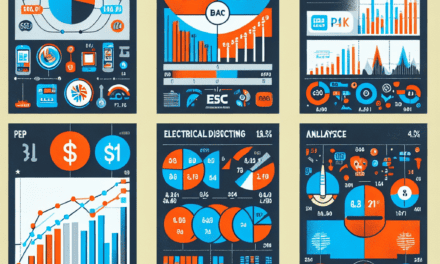“Bond Traders Eye Rate Cuts: Employment Data Fuels Fed Speculation”
Introduction
Bond traders have renewed their bets on potential Federal Reserve rate cuts following the release of recent employment data, which has provided fresh insights into the state of the U.S. labor market. The data, which showed unexpected shifts in employment figures, has prompted market participants to reassess their expectations regarding the Fed’s monetary policy trajectory. As investors digest the implications of the employment report, bond markets are experiencing heightened activity, reflecting the evolving sentiment around interest rate adjustments. This market update delves into the factors influencing bond traders’ renewed focus on rate cuts and the potential impact on financial markets.
Impact Of Employment Data On Bond Traders’ Rate Cut Expectations
The recent release of employment data has significantly influenced bond traders’ expectations regarding potential Federal Reserve rate cuts. As the labor market remains a critical indicator of economic health, any shifts in employment figures can have profound implications for monetary policy. The latest data, which revealed a slowdown in job creation, has prompted traders to reassess their outlook on the Federal Reserve’s future actions. This reassessment is rooted in the belief that a cooling labor market may compel the Fed to adopt a more accommodative stance to support economic growth.
In light of the new employment figures, bond traders have renewed their bets on the likelihood of rate cuts. The data showed a deceleration in job growth, with fewer jobs added than anticipated. This slowdown suggests that the economy may be losing some of its momentum, raising concerns about its ability to sustain current growth levels. Consequently, traders are increasingly factoring in the possibility that the Federal Reserve might intervene by reducing interest rates to stimulate economic activity.
Moreover, the employment data has also highlighted underlying weaknesses in certain sectors, further fueling speculation about potential rate cuts. For instance, industries such as manufacturing and retail have shown signs of strain, with job losses or minimal growth reported. These sector-specific challenges underscore the broader economic vulnerabilities that could prompt the Fed to reconsider its monetary policy stance. As a result, bond traders are closely monitoring these developments, adjusting their strategies to align with the evolving economic landscape.
Additionally, the employment data has implications for inflation expectations, which are a key consideration for the Federal Reserve when determining interest rate policy. A softer labor market could lead to subdued wage growth, thereby exerting downward pressure on inflation. In such a scenario, the Fed might feel more comfortable implementing rate cuts, as the risk of overheating the economy diminishes. This potential shift in inflation dynamics is another factor that bond traders are weighing as they renew their rate cut bets.
Furthermore, the global economic environment adds another layer of complexity to the situation. With uncertainties such as geopolitical tensions and trade disputes still looming, the Federal Reserve may be inclined to adopt a more cautious approach. A rate cut could serve as a preemptive measure to shield the domestic economy from external shocks. Bond traders, aware of these global risks, are factoring them into their expectations, further reinforcing the case for potential rate cuts.
In conclusion, the recent employment data has played a pivotal role in shaping bond traders’ expectations regarding Federal Reserve rate cuts. The slowdown in job growth, coupled with sector-specific challenges and subdued inflation prospects, has led traders to renew their bets on the likelihood of monetary easing. As they navigate this complex economic landscape, traders are keenly attuned to both domestic and global factors that could influence the Fed’s decision-making process. Ultimately, the interplay between employment data and monetary policy expectations underscores the intricate dynamics that bond traders must consider as they position themselves in the market.
Analyzing The Fed’s Potential Rate Cut: Insights For Bond Traders
In the wake of the latest employment data release, bond traders have renewed their bets on potential rate cuts by the Federal Reserve, reflecting a shift in market sentiment. The employment figures, which showed a deceleration in job growth, have prompted investors to reassess the economic landscape and the Fed’s possible monetary policy responses. This development is crucial for bond traders, as interest rate changes significantly impact bond prices and yields.
The employment report revealed that job creation was slower than anticipated, with fewer positions added to the economy than in previous months. This slowdown in hiring has raised concerns about the robustness of the economic recovery, particularly in the face of ongoing global uncertainties and domestic challenges. As a result, market participants are increasingly speculating that the Federal Reserve might consider cutting interest rates to stimulate economic activity and support labor market conditions.
Transitioning to the implications for bond traders, the prospect of a rate cut typically leads to a decrease in bond yields, as lower interest rates make existing bonds with higher yields more attractive. Consequently, bond prices tend to rise in anticipation of such policy moves. Traders are now closely monitoring the Fed’s communications and economic indicators to gauge the likelihood and timing of any potential rate adjustments. This heightened attention to the Fed’s policy direction underscores the importance of staying informed and agile in the bond market.
Moreover, the renewed focus on rate cuts highlights the delicate balance the Federal Reserve must maintain between fostering economic growth and controlling inflation. While a rate cut could provide a boost to economic activity, it also carries the risk of exacerbating inflationary pressures if not carefully calibrated. Therefore, bond traders must consider not only the immediate effects of potential rate changes but also the broader economic context and the Fed’s long-term objectives.
In addition to domestic factors, global economic conditions play a significant role in shaping the Fed’s policy decisions. Ongoing geopolitical tensions, supply chain disruptions, and varying recovery rates across different regions contribute to the complexity of the economic environment. These factors can influence the Fed’s assessment of risks and opportunities, thereby affecting its policy stance. Bond traders, therefore, need to maintain a global perspective when analyzing potential rate cuts and their implications for the market.
Furthermore, the interplay between fiscal policy and monetary policy is another critical consideration for bond traders. Government spending initiatives and fiscal stimulus measures can impact economic growth and inflation, thereby influencing the Fed’s policy decisions. As such, traders must remain vigilant in tracking fiscal developments and their potential effects on the bond market.
In conclusion, the renewed bets on Fed rate cuts following the latest employment data underscore the dynamic nature of the bond market and the importance of staying informed about economic indicators and policy developments. Bond traders must navigate a complex landscape, balancing domestic and global factors, while considering the interplay between fiscal and monetary policies. By maintaining a comprehensive understanding of these elements, traders can better position themselves to capitalize on opportunities and manage risks in an ever-evolving market environment.
Employment Data And Its Influence On Federal Reserve Decisions
The recent release of employment data has reignited discussions among bond traders regarding potential Federal Reserve rate cuts. This development comes as market participants closely analyze the implications of labor market trends on monetary policy decisions. The employment figures, which serve as a critical indicator of economic health, have shown signs of moderation, prompting traders to reassess their expectations for future interest rate adjustments by the Federal Reserve.
In recent months, the labor market has been a focal point for economists and policymakers alike, as it provides valuable insights into the broader economic landscape. The latest data revealed a deceleration in job growth, with fewer jobs added than anticipated. This slowdown has raised questions about the sustainability of the current economic expansion and has led to increased speculation about the Federal Reserve’s next moves. As a result, bond traders have begun to renew their bets on potential rate cuts, anticipating that the central bank may seek to provide additional support to the economy.
The Federal Reserve’s dual mandate of promoting maximum employment and maintaining stable prices often requires a delicate balancing act. In periods of robust job growth, the central bank may opt to raise interest rates to prevent the economy from overheating and to keep inflation in check. Conversely, when employment data suggests a cooling labor market, the Fed may consider lowering rates to stimulate economic activity. The recent employment figures, therefore, play a crucial role in shaping market expectations regarding the Fed’s policy trajectory.
Moreover, the interplay between employment data and Federal Reserve decisions is further complicated by external factors such as geopolitical tensions and global economic uncertainties. These elements can influence the central bank’s assessment of economic conditions and its subsequent policy actions. In this context, bond traders are keenly attuned to any signals from the Fed that might indicate a shift in its monetary policy stance. The renewed focus on rate cuts reflects a broader sentiment that the central bank may prioritize supporting growth amid potential headwinds.
In addition to employment data, other economic indicators such as inflation rates, consumer spending, and business investment are also closely monitored by both the Federal Reserve and market participants. These metrics provide a comprehensive view of the economy’s health and inform the central bank’s policy decisions. However, the labor market remains a particularly influential factor, given its direct impact on consumer confidence and spending, which are vital components of economic growth.
As bond traders adjust their strategies in response to the latest employment data, the financial markets are likely to experience increased volatility. This dynamic environment underscores the importance of staying informed about economic developments and their potential implications for monetary policy. For investors, understanding the relationship between employment data and Federal Reserve decisions is essential for making informed investment choices.
In conclusion, the recent employment data has prompted bond traders to renew their bets on potential Federal Reserve rate cuts, highlighting the significant influence of labor market trends on monetary policy decisions. As the central bank navigates a complex economic landscape, market participants will continue to closely monitor employment figures and other key indicators to gauge the Fed’s future actions. This ongoing analysis underscores the critical role of employment data in shaping expectations and guiding investment strategies in the ever-evolving financial markets.
How Bond Traders React To Shifts In Employment Statistics

Bond traders are once again recalibrating their expectations for Federal Reserve interest rate cuts, spurred by the latest employment data. This shift in sentiment underscores the intricate relationship between labor market indicators and monetary policy decisions. As employment statistics serve as a critical barometer for economic health, they invariably influence the bond market’s outlook on future interest rate movements.
The recent employment report, which revealed a slowdown in job creation, has prompted traders to reassess the likelihood of the Federal Reserve adopting a more accommodative stance. Historically, robust employment figures have been associated with economic expansion, often leading the Fed to consider tightening monetary policy to prevent overheating. Conversely, weaker employment data can signal economic deceleration, prompting the central bank to contemplate rate cuts to stimulate growth.
In this context, the latest employment figures have reignited discussions among bond traders about the potential for rate cuts. The data indicated a deceleration in job growth, with fewer jobs added than anticipated. This development has led to increased speculation that the Federal Reserve might pivot towards a more dovish policy stance to support the economy. Consequently, bond traders are adjusting their portfolios to reflect the heightened probability of rate cuts, which typically result in lower yields on government securities.
Moreover, the bond market’s reaction to employment data is not solely based on headline job numbers. Traders also scrutinize other labor market indicators, such as wage growth and labor force participation rates, to gain a comprehensive understanding of the employment landscape. In the recent report, wage growth remained subdued, suggesting that inflationary pressures might be less pronounced than previously thought. This aspect further bolsters the case for potential rate cuts, as the Federal Reserve may have more leeway to lower rates without stoking inflation.
Additionally, the bond market’s response to employment data is influenced by broader economic conditions and geopolitical factors. For instance, ongoing trade tensions and global economic uncertainties can exacerbate concerns about domestic economic growth, thereby reinforcing the case for a more accommodative monetary policy. In such scenarios, bond traders are likely to anticipate rate cuts as a preemptive measure by the Federal Reserve to cushion the economy against external shocks.
Furthermore, the interplay between employment data and bond market expectations highlights the dynamic nature of financial markets. Traders must continuously adapt to new information and reassess their strategies in light of evolving economic conditions. This adaptability is crucial, as market sentiment can shift rapidly in response to unexpected developments, such as a sudden change in geopolitical dynamics or a surprise in economic data releases.
In conclusion, the recent employment data has prompted bond traders to renew their bets on Federal Reserve rate cuts, reflecting the intricate relationship between labor market indicators and monetary policy expectations. As traders analyze various facets of the employment report, including job growth, wage trends, and participation rates, they adjust their strategies to align with the anticipated trajectory of interest rates. This ongoing recalibration underscores the importance of employment statistics in shaping market sentiment and guiding investment decisions in the bond market. As economic conditions continue to evolve, bond traders will remain vigilant, ready to respond to new data and adjust their expectations accordingly.
The Relationship Between Employment Data And Bond Market Movements
The intricate relationship between employment data and bond market movements has once again come into focus as bond traders renew their bets on potential Federal Reserve rate cuts. This renewed interest follows the release of recent employment data, which has provided fresh insights into the health of the labor market and its implications for monetary policy. Understanding this relationship is crucial for investors and policymakers alike, as it influences decisions that can have far-reaching economic consequences.
Employment data, particularly the monthly non-farm payroll report, serves as a key indicator of economic vitality. It provides a snapshot of job creation, unemployment rates, and wage growth, all of which are critical factors in assessing the overall economic landscape. When employment data suggests robust job growth and rising wages, it typically signals a strong economy, potentially leading the Federal Reserve to consider tightening monetary policy through interest rate hikes. Conversely, weaker employment figures can indicate economic sluggishness, prompting the Fed to contemplate rate cuts to stimulate growth.
In the current scenario, the latest employment data has shown signs of a cooling labor market, with job creation numbers falling short of expectations and wage growth appearing to plateau. This has led bond traders to reassess their expectations regarding the Federal Reserve’s future actions. As a result, there has been a noticeable shift in market sentiment, with traders increasingly betting on the possibility of rate cuts in the near term. This shift is reflected in the bond market, where yields have adjusted in anticipation of potential monetary easing.
The bond market is highly sensitive to changes in interest rate expectations, as bond prices and yields move inversely. When traders anticipate rate cuts, bond prices tend to rise, leading to a decline in yields. This is because lower interest rates make existing bonds with higher yields more attractive, driving up their prices. Consequently, the recent employment data has triggered a rally in bond prices, as traders position themselves for a potential easing of monetary policy.
Moreover, the relationship between employment data and bond market movements is further complicated by the broader economic context. Inflationary pressures, geopolitical uncertainties, and global economic trends all play a role in shaping market expectations. In this environment, the Federal Reserve faces the delicate task of balancing its dual mandate of promoting maximum employment and maintaining price stability. The central bank must carefully weigh the implications of employment data against other economic indicators to determine the appropriate course of action.
In addition to influencing bond market movements, employment data also impacts other financial markets, including equities and currencies. For instance, expectations of rate cuts can boost stock markets, as lower borrowing costs can enhance corporate profitability and stimulate investment. Similarly, currency markets may react to changes in interest rate expectations, as rate cuts can lead to a depreciation of the domestic currency.
In conclusion, the relationship between employment data and bond market movements is a complex and dynamic interplay that reflects broader economic conditions and monetary policy expectations. As bond traders renew their bets on potential Federal Reserve rate cuts following the latest employment data, it underscores the importance of closely monitoring labor market trends and their implications for financial markets. This ongoing analysis is essential for making informed investment decisions and understanding the potential trajectory of monetary policy in an ever-evolving economic landscape.
Federal Reserve Rate Cuts: What Bond Traders Need To Know
In the ever-evolving landscape of financial markets, bond traders are once again recalibrating their expectations regarding Federal Reserve rate cuts, spurred by the latest employment data. This renewed focus on potential rate adjustments underscores the intricate relationship between economic indicators and monetary policy decisions. As traders digest the implications of the recent employment figures, it becomes crucial to understand how these data points influence the Federal Reserve’s approach to interest rates and, consequently, the bond market.
The employment data, often seen as a barometer of economic health, plays a pivotal role in shaping the Federal Reserve’s monetary policy. When employment figures indicate robust job growth and declining unemployment rates, the Fed may perceive the economy as overheating, prompting considerations for rate hikes to prevent inflation. Conversely, weaker employment data can signal economic sluggishness, leading to discussions about rate cuts to stimulate growth. In this context, the latest employment report has reignited discussions among bond traders about the likelihood of future rate cuts.
The recent employment data revealed a mixed picture, with job growth figures falling short of expectations while unemployment rates remained relatively stable. This nuanced scenario has led bond traders to reassess their strategies, as they weigh the potential for the Federal Reserve to adopt a more accommodative stance. The anticipation of rate cuts often results in increased demand for bonds, as lower interest rates make existing bonds with higher yields more attractive. Consequently, bond prices tend to rise, and yields fall, reflecting the market’s expectations of future monetary easing.
Moreover, the Federal Reserve’s dual mandate of promoting maximum employment and ensuring price stability adds another layer of complexity to the decision-making process. While the employment data is a critical component, the Fed also closely monitors inflation trends. Recent inflationary pressures have been a cause for concern, with rising prices affecting consumer purchasing power and business costs. However, if the employment data suggests a cooling labor market, the Fed might prioritize supporting economic growth over curbing inflation, thereby increasing the likelihood of rate cuts.
In addition to domestic economic indicators, global factors also influence the Federal Reserve’s policy decisions. Geopolitical tensions, trade dynamics, and international economic conditions can all impact the U.S. economy, prompting the Fed to adjust its approach accordingly. Bond traders, therefore, must remain vigilant, considering both domestic and international developments when formulating their strategies.
As bond traders navigate this complex environment, effective risk management becomes paramount. The potential for rate cuts introduces both opportunities and challenges, requiring traders to carefully assess their portfolios and adjust their positions in response to shifting market dynamics. Diversification, hedging strategies, and staying informed about economic indicators are essential tools for managing risk in a volatile market.
In conclusion, the renewed focus on Federal Reserve rate cuts following the latest employment data highlights the intricate interplay between economic indicators and monetary policy. Bond traders must remain attuned to these developments, as they have significant implications for market dynamics and investment strategies. By understanding the factors influencing the Fed’s decisions and adopting prudent risk management practices, traders can navigate the complexities of the bond market with greater confidence. As the economic landscape continues to evolve, staying informed and adaptable will be key to capitalizing on opportunities and mitigating risks in the pursuit of financial success.
Market Update: Employment Data’s Role In Shaping Fed Policy Expectations
In the ever-evolving landscape of financial markets, bond traders are once again recalibrating their expectations for Federal Reserve policy, spurred by the latest employment data. This renewed focus on potential rate cuts underscores the intricate relationship between labor market indicators and monetary policy decisions. As investors digest the nuances of the employment report, the implications for future interest rate adjustments become a focal point of market speculation.
The recent employment data revealed a mixed picture, with job growth figures slightly below expectations, yet unemployment rates remaining relatively stable. This duality presents a conundrum for policymakers and market participants alike. On one hand, the slower pace of job creation suggests a cooling labor market, which could alleviate inflationary pressures. On the other hand, the steady unemployment rate indicates that the economy is not yet in distress, complicating the narrative for immediate policy intervention.
In light of these developments, bond traders are increasingly betting on the possibility of rate cuts by the Federal Reserve. This shift in sentiment is driven by the belief that the central bank may need to adopt a more accommodative stance to sustain economic momentum. Historically, the Fed has been responsive to labor market signals, adjusting interest rates to either stimulate growth or curb inflation. Therefore, the latest employment figures are being scrutinized for clues about the Fed’s next move.
Moreover, the broader economic context cannot be ignored. Global uncertainties, including geopolitical tensions and trade dynamics, continue to cast a shadow over economic prospects. These external factors add another layer of complexity to the Fed’s decision-making process, as they weigh the potential risks of maintaining current interest rate levels against the benefits of a preemptive cut. Consequently, bond traders are factoring in these global considerations as they reassess their positions.
Transitioning to the market’s reaction, the bond market has exhibited heightened volatility in response to the employment data. Yields on government securities have fluctuated as traders adjust their portfolios to align with their revised expectations. This volatility reflects the broader uncertainty surrounding the Fed’s policy trajectory, as investors grapple with the implications of a potential shift in monetary policy.
Furthermore, the interplay between employment data and inflation expectations is pivotal in shaping market sentiment. While the current inflationary environment remains a concern, the prospect of a slowing labor market could temper inflationary pressures, providing the Fed with more leeway to consider rate cuts. This delicate balance between employment and inflation is at the heart of the Fed’s dual mandate, and bond traders are acutely aware of its significance.
In conclusion, the latest employment data has reignited discussions among bond traders regarding the Federal Reserve’s future policy actions. As they navigate the complexities of labor market dynamics and global uncertainties, traders are increasingly positioning themselves for the possibility of rate cuts. This renewed focus on monetary policy underscores the critical role that employment data plays in shaping market expectations. As the economic landscape continues to evolve, all eyes remain on the Fed, whose decisions will undoubtedly have far-reaching implications for financial markets and the broader economy.
Q&A
1. **What prompted bond traders to renew bets on Fed rate cuts?**
Recent employment data showing weaker-than-expected job growth prompted bond traders to renew bets on Federal Reserve rate cuts.
2. **How did the employment data influence market expectations?**
The employment data suggested a cooling labor market, leading traders to anticipate that the Fed might cut rates to support economic growth.
3. **What specific employment data was released?**
The data included lower-than-expected non-farm payroll numbers and a slight increase in the unemployment rate.
4. **How did bond yields react to the employment data?**
Bond yields fell as traders adjusted their expectations for future interest rate cuts by the Federal Reserve.
5. **What are the implications of renewed rate cut bets for the bond market?**
Renewed rate cut bets typically lead to increased demand for bonds, driving prices up and yields down.
6. **How might the Federal Reserve respond to the employment data?**
The Federal Reserve might consider rate cuts if the data indicates sustained economic weakness, although they will likely assess additional economic indicators before making a decision.
7. **What other economic indicators are traders watching?**
Traders are closely monitoring inflation rates, consumer spending, and GDP growth to gauge the overall economic outlook and potential Fed actions.
Conclusion
Following the release of recent employment data, bond traders have renewed their expectations for potential Federal Reserve rate cuts. The employment figures, which may have indicated slower job growth or other economic weaknesses, have prompted market participants to anticipate a more accommodative monetary policy stance from the Fed. This shift in sentiment is reflected in the bond market, where traders are adjusting their positions in anticipation of lower interest rates. The renewed bets on rate cuts suggest that traders believe the Fed may need to take action to support economic growth, potentially reversing previous rate hikes. This development underscores the dynamic nature of market expectations and the influence of economic indicators on monetary policy projections.





